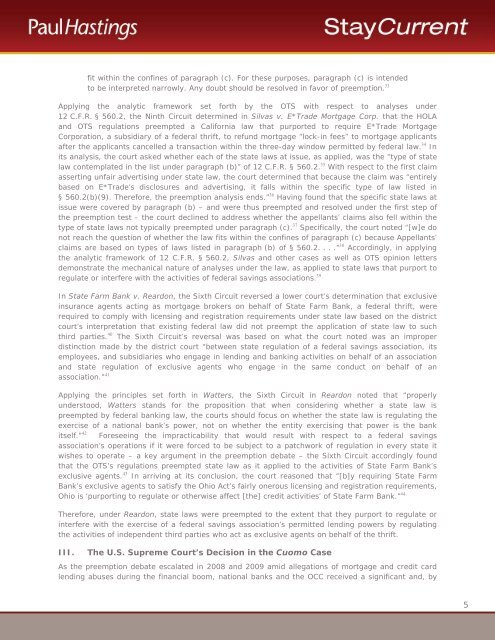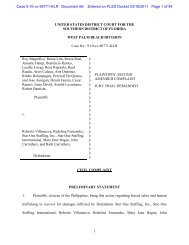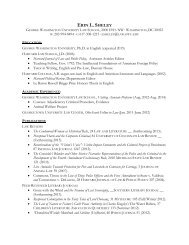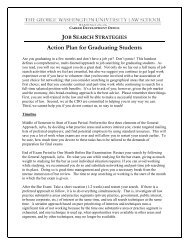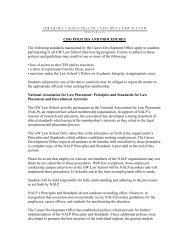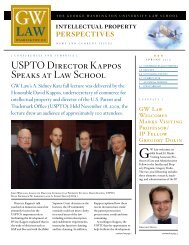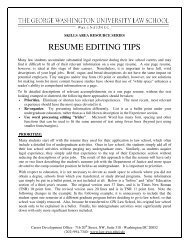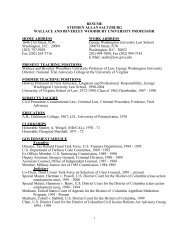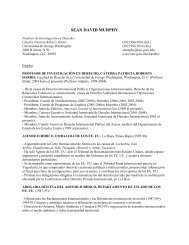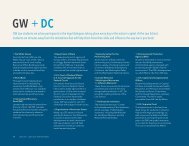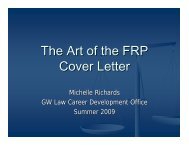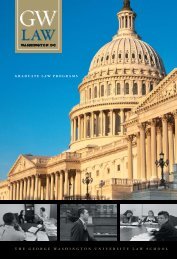CLE Materials for Panel #1 - George Washington University Law ...
CLE Materials for Panel #1 - George Washington University Law ...
CLE Materials for Panel #1 - George Washington University Law ...
Create successful ePaper yourself
Turn your PDF publications into a flip-book with our unique Google optimized e-Paper software.
fit within the confines of paragraph (c). For these purposes, paragraph (c) is intended<br />
to be interpreted narrowly. Any doubt should be resolved in favor of preemption. 33<br />
Applying the analytic framework set <strong>for</strong>th by the OTS with respect to analyses under<br />
12 C.F.R. § 560.2, the Ninth Circuit determined in Silvas v. E*Trade Mortgage Corp. that the HOLA<br />
and OTS regulations preempted a Cali<strong>for</strong>nia law that purported to require E*Trade Mortgage<br />
Corporation, a subsidiary of a federal thrift, to refund mortgage “lock-in fees” to mortgage applicants<br />
after the applicants cancelled a transaction within the three-day window permitted by federal law. 34 In<br />
its analysis, the court asked whether each of the state laws at issue, as applied, was the “type of state<br />
law contemplated in the list under paragraph (b)” of 12 C.F.R. § 560.2. 35 With respect to the first claim<br />
asserting unfair advertising under state law, the court determined that because the claim was “entirely<br />
based on E*Trade’s disclosures and advertising, it falls within the specific type of law listed in<br />
§ 560.2(b)(9). There<strong>for</strong>e, the preemption analysis ends.” 36 Having found that the specific state laws at<br />
issue were covered by paragraph (b) – and were thus preempted and resolved under the first step of<br />
the preemption test – the court declined to address whether the appellants’ claims also fell within the<br />
type of state laws not typically preempted under paragraph (c). 37 Specifically, the court noted “[w]e do<br />
not reach the question of whether the law fits within the confines of paragraph (c) because Appellants’<br />
claims are based on types of laws listed in paragraph (b) of § 560.2. . . .” 38 Accordingly, in applying<br />
the analytic framework of 12 C.F.R. § 560.2, Silvas and other cases as well as OTS opinion letters<br />
demonstrate the mechanical nature of analyses under the law, as applied to state laws that purport to<br />
regulate or interfere with the activities of federal savings associations. 39<br />
In State Farm Bank v. Reardon, the Sixth Circuit reversed a lower court’s determination that exclusive<br />
insurance agents acting as mortgage brokers on behalf of State Farm Bank, a federal thrift, were<br />
required to comply with licensing and registration requirements under state law based on the district<br />
court’s interpretation that existing federal law did not preempt the application of state law to such<br />
third parties. 40 The Sixth Circuit’s reversal was based on what the court noted was an improper<br />
distinction made by the district court “between state regulation of a federal savings association, its<br />
employees, and subsidiaries who engage in lending and banking activities on behalf of an association<br />
and state regulation of exclusive agents who engage in the same conduct on behalf of an<br />
association.” 41<br />
Applying the principles set <strong>for</strong>th in Watters, the Sixth Circuit in Reardon noted that “properly<br />
understood, Watters stands <strong>for</strong> the proposition that when considering whether a state law is<br />
preempted by federal banking law, the courts should focus on whether the state law is regulating the<br />
exercise of a national bank’s power, not on whether the entity exercising that power is the bank<br />
itself.” 42 Foreseeing the impracticability that would result with respect to a federal savings<br />
association’s operations if it were <strong>for</strong>ced to be subject to a patchwork of regulation in every state it<br />
wishes to operate – a key argument in the preemption debate – the Sixth Circuit accordingly found<br />
that the OTS’s regulations preempted state law as it applied to the activities of State Farm Bank’s<br />
exclusive agents. 43 In arriving at its conclusion, the court reasoned that “[b]y requiring State Farm<br />
Bank’s exclusive agents to satisfy the Ohio Act’s fairly onerous licensing and registration requirements,<br />
Ohio is ‘purporting to regulate or otherwise affect [the] credit activities’ of State Farm Bank.” 44<br />
There<strong>for</strong>e, under Reardon, state laws were preempted to the extent that they purport to regulate or<br />
interfere with the exercise of a federal savings association’s permitted lending powers by regulating<br />
the activities of independent third parties who act as exclusive agents on behalf of the thrift.<br />
III.<br />
The U.S. Supreme Court’s Decision in the Cuomo Case<br />
As the preemption debate escalated in 2008 and 2009 amid allegations of mortgage and credit card<br />
lending abuses during the financial boom, national banks and the OCC received a significant and, by<br />
5<br />
5


